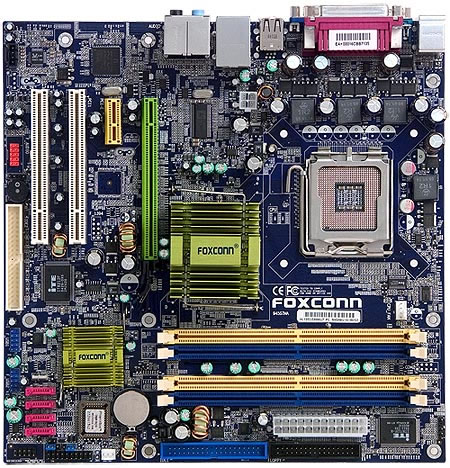 |
||
|
||
| ||
Foxconn motherboards (as well as mobos from many other manufacturers),
based on chipsets with integrated video, are traditionally designed
in microATX form factor (for example, 915M07-G-8EKRS
and 915M03-G-8EKRS2).
The model under review possesses unassuming functionality for a motherboard
on the latest chipset from Intel, but on the other hand this fact
should have a positive effect on the price to consumer. On the whole,
a gigabit network adapter, Serial ATA II support, and High Definition
Audio will satisfy most common users, though they are usual attributes
of state-of-the-art systems. Besides, the 945G7MA-8KS2 model has an
advantage - integrated video controller Intel GMA 950, which demonstrates
quite acceptable (for integrated video, of course) results.  On the whole, the PCB layout is successful, though its miniature dimensions lead to tightly packed connectors: IDE and PCI, FDD and the main power connector, DIMM and video PCIEx16. Access to the jumpers is not hampered even when the motherboard is in a case. There are no brief descriptions of jumper functions on the PCB. The 4-phase switching voltage regulator of the processor incorporates six 3300 uF capacitors, one 2200 uF capacitor, and four 1500 uF ones. The memory voltage regulator contains 3300, 2200 and 1500 uF capacitors as well as seven 470 uF ones reinforced with L-elements. In general, critical circuits incorporate electrolytic capacitors from Rubycon, Nippon Chemi-Con (high quality and reliable components) and less reputable components from Lelon. The model under review has an "elder sister" 945G7MA-8EKRS2, based on the same PCB, but with an on-board FireWire controller and ICH7R southbridge (hard drives connected to SATA connectors can form RAID 0, 1, 10(0+1), 5, and Matrix RAID). PCB dimensions - 245x245 mm (standard microATX, the board is firmly mounted with eight screws). System monitoring (ITE IT8712F-A):
Onboard ports, sockets, and connectors
Back panel (left to right, blockwise) Click the image to open the rear view of this motherboard
Package Contents
The bundle includes all necessary SATA power converters (it will come in handy, if your PSU is not equipped with such connectors) and Norton Internet Security 2004 — a good personal firewall. Foxconn SuperUtilites package is a typical set of utilities: SuperStep (to overclock and monitor system parameters), SuperLogo (to change the graphic logo at startup), and SuperUpdate (to search for the latest BIOS version via Internet and to flash the loaded image). Integrated Controllers
Interestingly, in order to support two additional IDE devices, our sample has the ITE IT8212F controller, which is actually a dual channel IDE RAID controller (RAID 0+1 for 4 devices). In case of the 945G7MA-8KS2, only half of its capacities can be used, as the board contains only one ["non-chipset"] IDE connector. We can only guess whether these motherboards will have a different controller later on (layout-compatible?) or Foxconn gets these chips at a moderate price. The available documentation does not specify a model of this controller. The integrated audio quality was tested in 16bit, 44 kHz using the RightMark
Audio Analyzer 5.5 test application and the Terratec
DMX 6fire sound card:
General performance: Good (Details). There is nothing unusual about the quality of analog audio output in this motherboard. Proprietary technologies
Settings
We used BIOS dated 21.04.2005, the latest available BIOS version at the time of our tests. The mentioned BIOS parameters are available in this version, but the viability of non-standard settings hasn't been tested. Preliminary test resultsTestbed configurations:
The table below contains the results demonstrated by the first motherboards on i945P/G that we reviewed and the results of the fastest (according to the roundup of six motherboards on Intel 925XE) i925XE representative — Gigabyte 8AENXP-D. We have also tested our model with the integrated video (Intel Graphics Media Accelerator 950).
All motherboards demonstrated similar results with this testbed configuration. Gigabyte 8AENXP-D, equipped with the i925XE chipset of the previous generation, not only keeps on the level with all its competitors, but it even manages to demonstrate higher results in some tests! However, it's an advantage of this model rather than the defects of the new motherboards — Intel 945/955 series chipsets are not intended to noticeably outperform representatives of the previous generation (i915/925). Besides, an indisputable advantage of the Gigabyte 8I945P-G and the Foxconn 945G7MA-8KS2 is their support for dual core processors. Another point: judging from the preliminary results, the new generation of integrated video from Intel is quite justified and can be a good substitute for discrete video in some cases. We shall soon publish a large roundup of motherboards on i945P/G and i955X chipsets and determine what model is the fastest. We shall also compare their performance characteristics with the motherboards on the main (for this moment) competitor to Intel chipsets — NVIDIA nForce4 SLI (Intel Edition).
This model on the manufacturer's web site
The motherboard is kindly provided by the manufacturer
Write a comment below. No registration needed!
|
Platform · Video · Multimedia · Mobile · Other || About us & Privacy policy · Twitter · Facebook Copyright © Byrds Research & Publishing, Ltd., 1997–2011. All rights reserved. | |||||||||||||||||||||||||||||||||||||||||||||||||||||||||||||||||||||||||||||||||||||||||||||||||||||||||||||||||||||||||||||||||